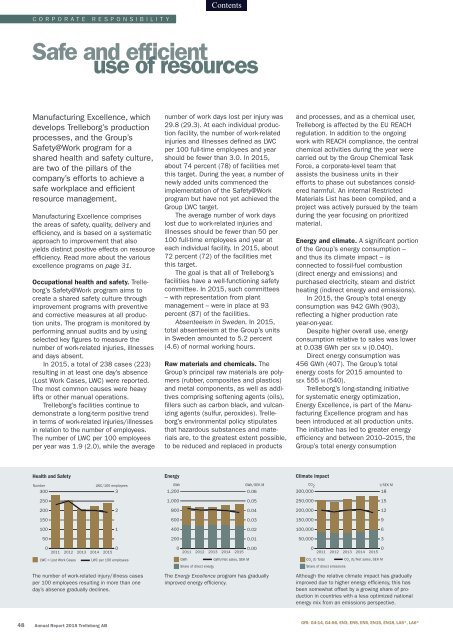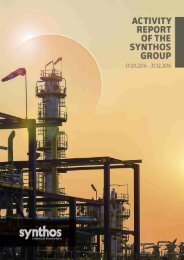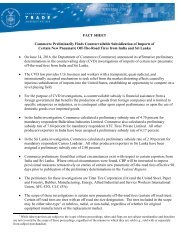We seal damp and protect
1o0Rrof
1o0Rrof
You also want an ePaper? Increase the reach of your titles
YUMPU automatically turns print PDFs into web optimized ePapers that Google loves.
CORPORATE RESPONSIBILITY<br />
Safe <strong>and</strong> efficient<br />
use of resources<br />
Manufacturing Excellence, which<br />
develops Trelleborg’s production<br />
processes, <strong>and</strong> the Group’s<br />
Safety@Work program for a<br />
shared health <strong>and</strong> safety culture,<br />
are two of the pillars of the<br />
company’s efforts to achieve a<br />
safe workplace <strong>and</strong> efficient<br />
resource management.<br />
Manufacturing Excellence comprises<br />
the areas of safety, quality, delivery <strong>and</strong><br />
efficiency, <strong>and</strong> is based on a systematic<br />
approach to improvement that also<br />
yields distinct positive effects on resource<br />
efficiency. Read more about the various<br />
excellence programs on page 31.<br />
Occupational health <strong>and</strong> safety. Trelleborg’s<br />
Safety@Work program aims to<br />
create a shared safety culture through<br />
improvement programs with preventive<br />
<strong>and</strong> corrective measures at all production<br />
units. The program is monitored by<br />
performing annual audits <strong>and</strong> by using<br />
selected key figures to measure the<br />
number of work-related injuries, illnesses<br />
<strong>and</strong> days absent.<br />
In 2015, a total of 238 cases (223)<br />
resulting in at least one day’s absence<br />
(Lost Work Cases, LWC) were reported.<br />
The most common causes were heavy<br />
lifts or other manual operations.<br />
Trelleborg’s facilities continue to<br />
demonstrate a long-term positive trend<br />
in terms of work-related injuries/illnesses<br />
in relation to the number of employees.<br />
The number of LWC per 100 employees<br />
per year was 1.9 (2.0), while the average<br />
number of work days lost per injury was<br />
29.8 (29.3). At each individual production<br />
facility, the number of work-related<br />
injuries <strong>and</strong> illnesses defined as LWC<br />
per 100 full-time employees <strong>and</strong> year<br />
should be fewer than 3.0. In 2015,<br />
about 74 percent (78) of facilities met<br />
this target. During the year, a number of<br />
newly added units commenced the<br />
implementation of the Safety@Work<br />
program but have not yet achieved the<br />
Group LWC target.<br />
The average number of work days<br />
lost due to work-related injuries <strong>and</strong><br />
illnesses should be fewer than 50 per<br />
100 full-time employees <strong>and</strong> year at<br />
each individual facility. In 2015, about<br />
72 percent (72) of the facilities met<br />
this target.<br />
The goal is that all of Trelleborg’s<br />
facilities have a well-functioning safety<br />
committee. In 2015, such committees<br />
– with representation from plant<br />
management – were in place at 93<br />
percent (87) of the facilities.<br />
Absenteeism in Sweden. In 2015,<br />
total absenteeism at the Group’s units<br />
in Sweden amounted to 5.2 percent<br />
(4.6) of normal working hours.<br />
Raw materials <strong>and</strong> chemicals. The<br />
Group’s principal raw materials are polymers<br />
(rubber, composites <strong>and</strong> plastics)<br />
<strong>and</strong> metal components, as well as additives<br />
comprising softening agents (oils),<br />
fillers such as carbon black, <strong>and</strong> vulcanizing<br />
agents (sulfur, peroxides). Trelleborg’s<br />
environmental policy stipulates<br />
that hazardous substances <strong>and</strong> materials<br />
are, to the greatest extent possible,<br />
to be reduced <strong>and</strong> replaced in products<br />
<strong>and</strong> processes, <strong>and</strong> as a chemical user,<br />
Trelleborg is affected by the EU REACH<br />
regulation. In addition to the ongoing<br />
work with REACH compliance, the central<br />
chemical activities during the year were<br />
carried out by the Group Chemical Task<br />
Force, a corporate-level team that<br />
assists the business units in their<br />
efforts to phase out substances considered<br />
harmful. An internal Restricted<br />
Materials List has been compiled, <strong>and</strong> a<br />
project was actively pursued by the team<br />
during the year focusing on prioritized<br />
material.<br />
Energy <strong>and</strong> climate. A significant portion<br />
of the Group’s energy consumption –<br />
<strong>and</strong> thus its climate impact – is<br />
connected to fossil-fuel combustion<br />
(direct energy <strong>and</strong> emissions) <strong>and</strong><br />
purchased electricity, steam <strong>and</strong> district<br />
heating (indirect energy <strong>and</strong> emissions).<br />
In 2015, the Group’s total energy<br />
consumption was 942 GWh (903),<br />
reflecting a higher production rate<br />
year-on-year.<br />
Despite higher overall use, energy<br />
consumption relative to sales was lower<br />
at 0.038 GWh per sek m (0.040).<br />
Direct energy consumption was<br />
456 GWh (407). The Group’s total<br />
energy costs for 2015 amounted to<br />
sek 555 m (540).<br />
Trelleborg’s long-st<strong>and</strong>ing initiative<br />
for systematic energy optimization,<br />
Energy Excellence, is part of the Manufacturing<br />
Excellence program <strong>and</strong> has<br />
been introduced at all production units.<br />
The initiative has led to greater energy<br />
efficiency <strong>and</strong> between 2010–2015, the<br />
Group’s total energy consumption<br />
Health <strong>and</strong> Safety<br />
Number<br />
300<br />
250<br />
200<br />
150<br />
100<br />
50<br />
0<br />
2011 2012<br />
LWC = Lost Work Cases<br />
LWC/100 employees<br />
3<br />
The number of work-related injury/illness cases<br />
per 100 employees resulting in more than one<br />
day’s absence gradually declines.<br />
2<br />
1<br />
0<br />
2013 2014 2015<br />
LWC per 100 employees<br />
Energy<br />
GWh<br />
1,200<br />
1,000<br />
800<br />
600<br />
400<br />
200<br />
0<br />
2011 2012<br />
GWh<br />
2013<br />
Share of direct energy<br />
2014<br />
2015<br />
GWh/Net sales, SEK M<br />
GWh/SEK M<br />
0.06<br />
0.05<br />
0.04<br />
0.03<br />
0.02<br />
0.01<br />
0.00<br />
The Energy Excellence program has gradually<br />
improved energy efficiency.<br />
Climate impact<br />
CO 2<br />
300,000<br />
250,000<br />
200,000<br />
150,000<br />
100,000<br />
50,000<br />
0<br />
2011 2012<br />
CO 2<br />
(t) Total<br />
Share of direct emissions<br />
t/SEK M<br />
0<br />
2013 2014 2015<br />
CO 2<br />
(t)/Net sales, SEK M<br />
Although the relative climate impact has gradually<br />
improved due to higher energy efficiency, this has<br />
been somewhat offset by a growing share of production<br />
in countries with a less optimized national<br />
energy mix from an emissions perspective.<br />
18<br />
15<br />
12<br />
9<br />
6<br />
3<br />
48 Annual Report 2015 Trelleborg AB<br />
GRI: G4-14, G4-56, EN3, EN5, EN6, EN15, EN18, LA5*, LA6*






